Mhairi Gowans introduces Charles McGhee, a black man who resided in Clare Market, the present day home of LSE, over the late 18th and early 19th centuries.
Charles McGhee is the name of a black street sweeper who once worked on the corner of Ludgate Circus. Originally from Jamaica, it has not been recorded when or how Charles came to London, but he spent his life in the city, living and working in the area between Ludgate and Drury Lane, ultimately dying in Chapel Court, which once stood roughly where LSE’s Centre Building is today.

He was described by historian William Purdie Treloar as having a short figure, with grey hair brushed into a toupee and wearing an assortment of cast-off garments. Charles stood daily and in all weathers at his “shop”, only leaving in the evening to sell nuts and oranges at the doors of local theatres. At Ludgate Circus, he met his great benefactress, the daughter of Alderman Waithman, who gave him money and ensured he had hot food. Between his own earnings at the busy crossing and the gifts from Miss Waithman, Charles must have done well for himself, as the word in the community was that Charles was always “in the funds”.
It appears from the written records that Charles was a much-loved local figure. The South London Chronicle in 1872 said: “His industry and civility won him friends” and that through him “flowed the richest and warmest life’s blood.” In this article, he was very favourably compared to another Clare Market resident, a miserly butcher who, after a lifetime of saving, was said to have spent the half hour before he died bargaining for a cheap coffin.
Charles’ retirement is recorded by William Purdie Treloar, suggesting that Charles was able to use his money to enjoy some rest in his old age. However, Treloar argues that he must have been very old when he retired as a portrait of him working aged 73 was hanging in a nearby Tavern. Today there are two known artworks depicting Charles. One was by the travelling artist John Dempsey, who painted many beggars, buskers and street sellers during his career. The other, pictured above, is an engraving by John Thomas Smith for his book Vagabondiana, in which he described London’s street sellers and vagrants.
Charles died at 87, a good age though much younger than the reported age of his father, who lived to 105. While his retirement suggests he used some of the wealth he had amassed in his own life, on his death, it turned out he had willed £7,000 to his benefactress, Miss Waithman, which the Bank of England’s inflation calculator works out as being the equivalent of over £5 million today.





